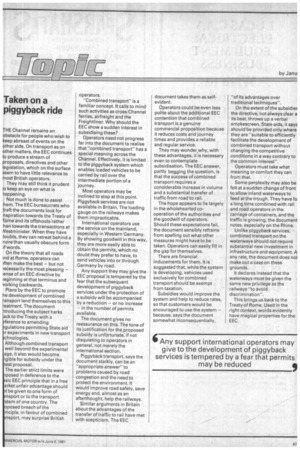Taken on a piggyback ride
Page 69

If you've noticed an error in this article please click here to report it so we can fix it.
THE Channel remains an obstacle for people who wish to keep abreast of events on the other side. On transport as on other matters, the EEC continues to produce a stream of proposals, directives and other legislation, which on the surface seem to have little relevance to most British operators.
They may still think it prudent to keep an eye on what is iappening.
Not much is done to assist :hem. The EEC bureaucrats who iraft the documents look for nspiration towards the Treaty of ome and its offshoots rather han towards the transactions at Nestminister. When they have Joubts, they can retreat behind a nore than usually obscure form )f words.
On the theory that all roads )nd at Rome, operators can rften make the best — but not iecessarily the most pleasing — ;ense of an EEC directive by teginning at that terminus and vorking backwards.
Plans by the EEC to promote he development of combined ransport lend themselves to this eatment. The document traducing the subject harks ack to the Treaty with a ference to amending gulations permitting State aid r experiments in new transport chnologies.
Although combined transport well beyond the experimental age, it also would become igible for subsidy under the test proposal.
The earlier strict limits were posed in deference to the sic EEC principle that in a free arket unfair advantage should t be given to one form of nsport or to the transport stem of one country. The oposed breach of the inciple, in favour of combined nsport, may surprise British operators.
"Combined transport" is a familiar concept. It calls to mind such activities as cross-Channel ferries, airfreight and the Freightliner. Why should the EEC show a sudden interest in subsidising these?
Operators need not progress far into the document to realise that "combined transport" has a special meaning across the Channel. Effectively, it is limited to the piggyback system which enables loaded vehicles to be carried by rail over the intermediate portion of a journey.
Most operators may be inclined to stop at this point. Piggyback services are not available in Britain. The loading gauge on the railways makes them impracticable.
International operators use the service on the mainland, especially in Western Germany. By showing goodwill in this way, they are more easily able to obtain the permits, which no doubt they prefer to have, to send vehicles into or through Germany by road.
Any support they may give the EEC proposal is tempered by the fear that the subsequent development of piggyback services under the protection of a subsidy will be accompanied by a reduction — or no increase — in the number of permits available.
The document gives no reassurance on this. The tone of its justification for the proposed subsidy is unfortunate, if not disquieting to operators in general, not merely the international section.
Piggyback transport, says the document starkly, can be an "appropriate answer" to problems caused by road congestion and the need to protect the environment. It would improve road safety, save energy and, almost as an afterthought, help the railways.
Similar arguments in Britain aboutthe advantages of the transfer of traffic to rail have met with scepticism. The EEC document takes them as selfevident.
Operators could be even less polite about the additional EEC contention that combined transport is a genuine commercial proposition because it reduces costs and journey times and provides a reliable and regular service.
They may wonder.why, with these advantages, it is necessary even to contemplate subsidisation. The EEC answer, partly begging the question, is that the success of combined transport requires a considerable increase in volume and a substantial transfer of traffic from road to rail.
The hope appears to lie largely in the wholehearted cooperation of the authorities and the goodwill of operators. Should these expectations fail, the document sensibly refrains from spelling out what other measures might have to be taken. Operators can easily fill in the gap for themselves.
There are financial inducements for them. It is suggested that, while the system is developing, vehicles used exclusively for combined transport should be exempt from taxation.
Subsidies would improve the system and help to reduce rates, so that customers would be encouraged to use the system — because, says the document somewhat inconsequentially, "of its advantages over traditional techniques".
On the extent of the subsidies the directive, not always clear a its best, throws up a verbal smokescreen. State aids, it says should be provided only where they are "suitable to efficiently facilitate the development of combined transport without changing the competitive conditions in a way contrary to the common interest".
Operators must take what meaning or comfort they can from that.
Some perplexity may also be felt at a sudden change of front to allow inland waterways to feed at the trough. They have to a long time combined with rail and road operators in the carriage of containers, and the traffic is growing, the document notes, especially on the Rhine.
Unlike piggyback services, combined transport on the waterways should not require substantial new investment in infrastructure and equipment. A any rate, the document does not make out a case on these grounds.
It declares instead that the waterways must be given the same new privilege as the railways "to avoid discrimination".
This brings us back to the Treaty of Rome. Used in the right context, words evidently have magical properties for the EEC.












































































































